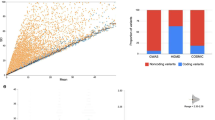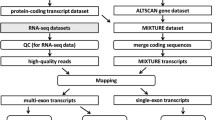Abstract
Background
With the completion of the human draft genome sequence, efforts are now devoted to identifying new genes. We have developed a computer-based strategy that utilizes the EST database to identify new genes that could be targets for the immunotherapy of cancer or could be involved in the multistep process of cancer.
Materials and Methods
Utilizing our computer-based screening strategy, we identified a cluster of expressed sequence tags (ESTs) that are highly expressed in breast cancer. Northern blot and reverse transcriptase polymerase chain reaction (RT-PCR) analyses demonstrated the tissue specificity of the computer-generated cluster and comparison with the human genome sequence assisted in isolating a full-length cDNA clone.
Results
We identified a new gene that is highly expressed in breast cancer. This gene is expressed at moderate levels in normal breast and testis and at very low levels in liver, brain, and placenta. The gene has two major transcripts of 4.5 kb and 4.1 kb. The 4.5-kb transcript is very abundant in breast cancer, and has an open reading frame of 1382 amino acids. The predicted protein sequence of the 4.5-kb transcript reveals that it has high homology with MRP5, a member of multidrug resistant-associated protein family (MRP). There are seven reported members in the MRP family; we designate this gene as MRP8 (ABCC11). The 4.5-kb MRP8 transcript consists of 31 exons and is located in a genomic region of over 80.4 kb on chromosome 16q12.1. The smaller 4.1-kb transcript of MRP8 is found in testis and may initiate within intron 6 of the gene.
Conclusion
The selective expression of MRP8 (ABCC11), a new member of ATP-binding cassette transporter super-family could be a molecular target for the treatment of breast cancer.






Similar content being viewed by others
References
Okubo K, Matsubara K. (1997) Complementary DNA sequence (EST) collections and the expression information of the human genome. FEBS Lett. 40: 225–229.
Burke J, Wang H, Hide W, Davison DB. (1998) Alternative gene form discovery and candidate gene selection from gene indexing projects. Genome Res. 8: 276–290.
Brinkmann U, Vasmatzis G, Lee B, Yerushalmi N, Essand M, Pastan I. (1998) PAGE-1, an X chromosome-linked GAGE-like gene that is expressed in normal and neoplastic prostate, testis, and uterus. Proc. Natl. Acad. Sci. U.S.A. 95: 10757–10762.
Brinkmann U, Vasmatzis G, Lee B, Pastan I. (1999) Novel genes in PAGE and GAGE family of tumor antigens found by homology walking in the dbEST database. Cancer Res. 59: 1445–1448.
Essand M, Vasmatzis G, Brinkmann U, Duray P, Lee B, Pastan I. (1999) High expression of a specific T-cell receptor gamma transcript in epithelial cells of the prostate. Proc. Natl. Acad. Sci. U.S.A. 96: 9287–9292.
Liu XF, Helman LJ, Yeung C, Bera TK, Lee B, Pastan I. (1999) XAGE-1, a new gene that is frequently expressed in Ewing’s sarcoma. Cancer Res. 60: 4752–4755.
Wolfgang CD, Essand M, Vincent JJ, Lee B, Pastan I. (2000) TARP: a novel protein expressed in prostate and breast cancer cells derived from an alternate reading frame of the TCRγ locus. Proc. Natl. Acad. Sci. U.S.A. 97: 9437–9442.
Vasmatzis G, Essand M, Brinkmann U, Lee B, Pastan I. (1998) Discovery of three genes specifically expressed in human prostate by expressed sequence tag database analysis. Proc. Natl. Acad. Sci. U.S.A. 95: 300–304.
Yeh R-F, Lim LP, Burge CB. (2001) Computational inference of homologous gene structures in the human genome. Genome Res. 11: 803–816.
Altschul SS, Gish W, Miller W, Myers EW, and Lipman DJ. (1990) Basic local alignment search tool. J. Mol. Biol. 215: 403–410.
Allikmets R, Gerrard B, Hutchinson A, Dean M. (1996) Characterization of the human ABC superfamily: Isolation and mapping of 21 new genes using the expressed sequence tags database. Hum. Mol. Genet. 5: 1649–1655.
Borst P, Evers R, Kool M, Wijnholds J. (2000) A family of drug transporters: The multidrug resistance-associated proteins. J. Natl. Cancer Inst. 92: 1295–1302.
McAleer MA, Breen MA, White NL, Matthews N. (1999) PABC11 (also known as MOAT-C and MRP5), a member of the ABC family of proteins, has anion transporter activity but does not confer multidrug resistance when overexpressed in human embryonic kidney 293 cells. J. Biol. Chem. 274: 23541–23548.
Tomita H, Nagamitsu S, Wakui K, Fukushima Y, Yamada K, Sadamatsu M, Masui A, Konishi T, Matsuishi T, Aihara M, Shimizu K, Hashimoto K, Mineta M, Matsushima M, Tsujita T, Saito M, Tanaka H, Tsuji S, Takagi T, Nakamura Y, Nanko S, Kato N, Nakane Y, Niikawa N (1999) Paroxysmal kinesigenic choreoathetosis locus maps to chromosome 16p11.2-q12.1. American Journal of Human Genetics 65:(6) 1688–1697.
Lee WL, Tay A, Ong HT, Goh LM, Monaco AP, Szepetowski P (1998) Association of infantile convulsions with paroxysmal dyskinesias (ICCA syndrome): confirmation of linkage to human chromosome 16p12-q12 in a Chinese family. Human Genetics 103:(5) 608–612.
Acknowledgments
We thank Drs. S. Ambudkar, J. Batra, K. Egland, K. Santora, C. Wolfgang, and M. Gallo for their comments and R. Mann for editorial assistance. S. Lee is thankful for partial financial support from the Center for Cell Signaling Research at Ewha Womans University, Seoul 120–750, Korea.
Author information
Authors and Affiliations
Corresponding author
Additional information
Contributed by I. Pastan.
Rights and permissions
About this article
Cite this article
Bera, T.K., Lee, S., Salvatore, G. et al. MRP8, A New Member of ABC Transporter Superfamily, Identified by EST Database Mining and Gene Prediction Program, Is Highly Expressed in Breast Cancer. Mol Med 7, 509–516 (2001). https://doi.org/10.1007/BF03401856
Accepted:
Published:
Issue Date:
DOI: https://doi.org/10.1007/BF03401856




